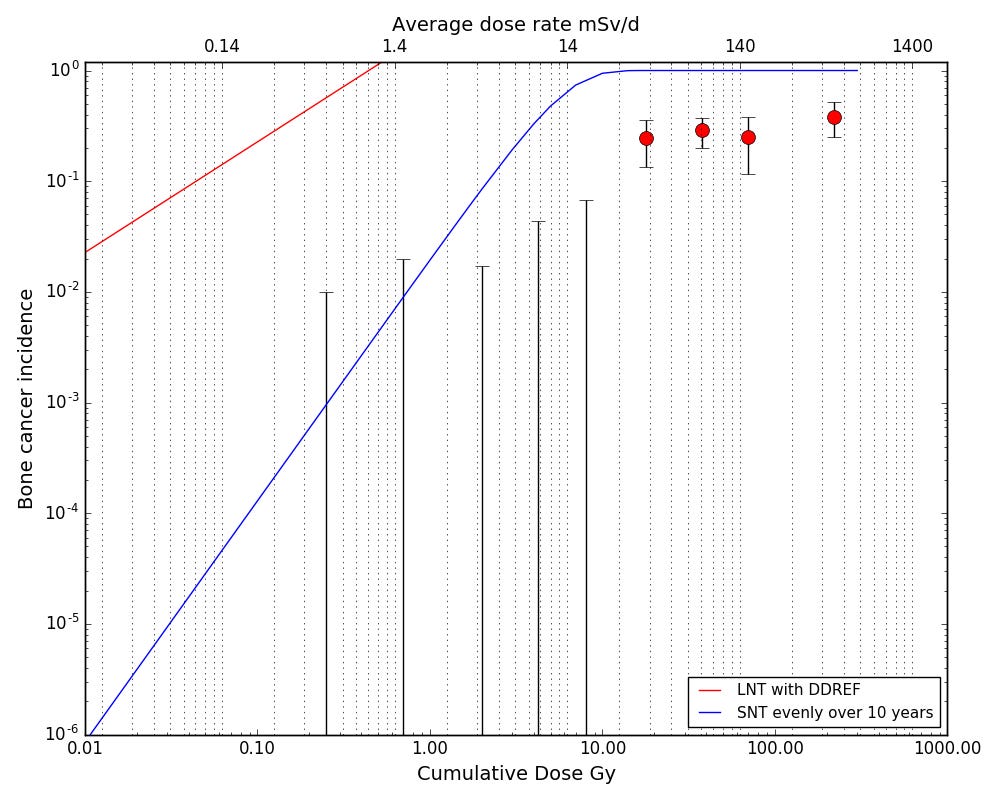The Radium Dial Painters and SNT
Figure 1. LNT and SNT versus Dial Painter Bone Cancer
The Gordian Knot Group is pushing Sigmoid No Threshold (SNT) as a replacement to the Linear No Threshold (LNT) radiation harm model. SNT requires dividing an individual's dose rate profile into repair periods (currently set at a day), fitting an S-shaped response curve to the dose in each repair period, and treating each repair period as an independent event. Once you have an estimate of the daily dose rate profiles and a computer, SNT is as easy to implement as LNT.
In our last post, we pointed out LNT failed the Huxley one-ugly-fact test. LNT's prediction of bone cancer incidence in radium dial painters who had received massive doses over a ten year plus period is off by orders of magnitude. Therefore, LNT is wrong and must be rejected. It is only fair that we subject SNT to the same test.
Unlike LNT, SNT does not ignore how rapidly or slowly the dose was received. SNT requires a daily dose rate profile. Radium dial painting started about 1915. In the late 1920's, the ladies were advised to stop licking the tips of their brush. That pretty much put a stop to the bone cancers.
If we assume the ladies received their dose evenly over 10 years, which is almost certainly conservative, then we can add an SNT prediction to the picture, Figure 1. I've switched the top axis to dose rate under this assumption. SNT claims we should have seen nearly no cancer up to about 2 mSv/day, but then the prediction turns sharply upward. The actual jump upward takes place at about 20 mSv/day. Moreover, at 20 mSv/d, SNT predicts a 99% incidence rate when the observed was less than 30%. However, unlike LNT, SNT avoids the absurdity of a cancer incidence greater than 1.0.
The charitable view of this is SNT is conservative by a factor of ten, in predicting the point at which dose rates become seriously harmful. This is close to a factor of 100 better than LNT. It is also important to note that, at the low dose rate end, while SNT and LNT are converging in absolute terms, simply because both cancer incidences are getting smaller, in relative terms they are diverging. This can be seen in Figure 2, the log/log version of Figure 1. As the dose rate goes to zero, SNT's cancer incidence declines much faster than LNT's. This is critical when we start combining tiny dose rates with immense exposed populations, such as happened at Chernobyl. At Chernobyl, LNT predicts 17,000 mortal cancers in the 3 billion people who received an additional 1 mSv or less over a year or more from the fall out. SNT predicts 0.13 deaths.\cite{flop}[p 140]
Figure 2. Log-log Dial Painter Bone Cancer.
Figure 2 makes the point that Evans, the lead researcher in the dial painter study, did not claim no possible harm up to 160 sieverts. He only claimed he had not observed any. Thus he was careful to show error bars for all his bins. We can't see zero on a log-log graph, but we can see his error bars. SNT is within the error bars up to 1 mSv/d. LNT never gets anywhere close to the error bars.
My takeaway is SNT is wrong; but it is a qualitatively different wrong than LNT. Furthermore, it is quantitatively acceptable at dose rates up to 1 mSv/day, even when that daily dose is repeated for years. Fortunately, the dose rates experienced by the public in a nuclear power plant release are almost never above 1 mSv/day and then only for a few weeks at most.
If we use SNT in a compensation scheme, the few people who do get hit with more than 1 mSv/day will be over-compensated. From a societal point on view, this is bad. Not only does this represent an inefficient allocation of resources; but it will cause unnecessary psychic trauma in the over-compensated. In the wrong hands, it could lead to unnecessary evacuations. But perhaps this is a price worth paying for SNT's simplicity and its multi-order of magnitude improvement over LNT.




Go SNT!
Thanks Jack, for this insightful summary.
You are highlighting bone-cancer-incident rates vs cumulative dose. Assuming an evenly distributed dose rate over 10 years is a good back-of-the-envelope assumption, and probably nothing better can be estimated today.
Where do you have the bone-cancer-incident rates from?
I always thought that tongue and lip cancer was the main problem with the dial painters?
Do you have such data?
What about other types of cancer, or are there any mortality rates known that could be used?
Painting dial faces was continued over many decades, probably till the end of the 50ies or even into the 60ies in some places. There may be more and more recent data available.
I am afraid that focusing on just one cancer type may not be enough to make a conclusive statement that would be accepted by all.
Continue your good work, and I am still standing that a) SNT is way better than LNT by orders of magnitude, but b) still not good enough.